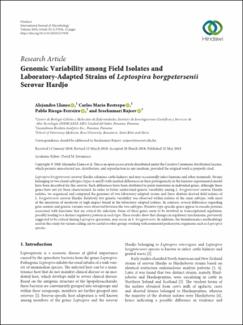| dc.contributor.author | Llanes, Alejandro | |
| dc.contributor.author | Restrepo, Carlos Mario | |
| dc.contributor.author | Ferreiro, Pablo Riesgo | |
| dc.contributor.author | Rajeev, Sreekumari | |
| dc.date.accessioned | 2020-06-12T20:56:31Z | |
| dc.date.available | 2020-06-12T20:56:31Z | |
| dc.date.issued | 2018-05-22 | |
| dc.identifier.other | doi.org/10.1155/2018/2137036 | |
| dc.identifier.uri | http://repositorio-indicasat.org.pa/handle/123456789/54 | |
| dc.description | Leptospira borgpetersenii serovar Hardjo colonizes cattle kidneys and may occasionally infect humans and other mammals. Strains belonging to two clonal subtypes (types A and B) with marked differences in their pathogenicity in the hamster experimental model have been described for this serovar. Such differences have been attributed to point mutations in individual genes, although those genes have not yet been characterized. In order to better understand genetic variability among L. borgpetersenii serovar Hardjo isolates, we sequenced and compared the genomes of two laboratory-adapted strains and three abattoir-derived field isolates of L. borgpetersenii serovar Hardjo. Relatively low genetic variability was observed within isolates of the same subtype, with most of the mutations of moderate or high impact found in the laboratory-adapted isolates. In contrast, several differences regarding gene content and genetic variants were observed between the two subtypes. Putative type-specific genes appear to encode proteins associated with functions that are critical for infection. Some of these genes seem to be involved in transcriptional regulation, possibly leading to a distinct regulatory pattern in each type. These results show that changes in regulatory mechanisms, previously suggested to be critical during Leptospira speciation, may occur in L. borgpetersenii. In addition, the bioinformatics methodology used in this study for variant calling can be useful to other groups working with nonmodel prokaryotic organisms such as Leptospira species. | en_US |
| dc.description.abstract | Leptospira borgpetersenii serovar Hardjo colonizes cattle kidneys and may occasionally infect humans and other mammals. Strains belonging to two clonal subtypes (types A and B) with marked differences in their pathogenicity in the hamster experimental model have been described for this serovar. Such differences have been attributed to point mutations in individual genes, although those genes have not yet been characterized. In order to better understand genetic variability among L. borgpetersenii serovar Hardjo isolates, we sequenced and compared the genomes of two laboratory-adapted strains and three abattoir-derived field isolates of L. borgpetersenii serovar Hardjo. Relatively low genetic variability was observed within isolates of the same subtype, with most of the mutations of moderate or high impact found in the laboratory-adapted isolates. In contrast, several differences regarding gene content and genetic variants were observed between the two subtypes. Putative type-specific genes appear to encode proteins associated with functions that are critical for infection. Some of these genes seem to be involved in transcriptional regulation, possibly leading to a distinct regulatory pattern in each type. These results show that changes in regulatory mechanisms, previously suggested to be critical during Leptospira speciation, may occur in L. borgpetersenii. In addition, the bioinformatics methodology used in this study for variant calling can be useful to other groups working with nonmodel prokaryotic organisms such as Leptospira species. | en_US |
| dc.format | application/pdf | |
| dc.language.iso | eng | en_US |
| dc.rights | Info:eu-repo/semantics/openAccess | |
| dc.rights | https://creativecommons.org/licenses/by/4.0/ | |
| dc.subject | Genomic Variability | en_US |
| dc.subject | Laboratory-Adapted Strains | en_US |
| dc.subject | Leptospira borgpetersenii Serovar Hardjo | en_US |
| dc.title | Genomic Variability among Field Isolates and Laboratory-Adapted Strains of Leptospira borgpetersenii Serovar Hardjo | en_US |
| dc.type | info:eu-repo/semantics/article | en_US |
| dc.type | Info:eu-repo/semantics/publishedversion | |

